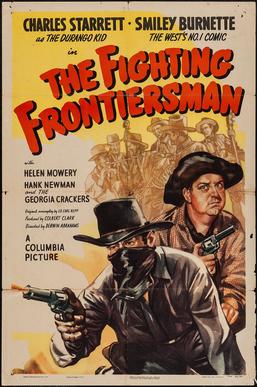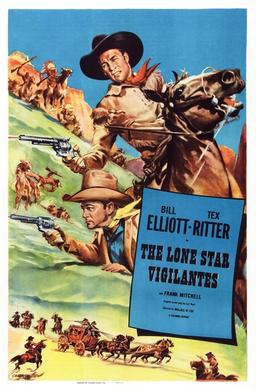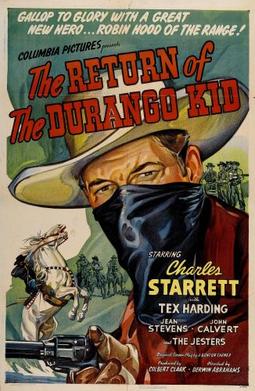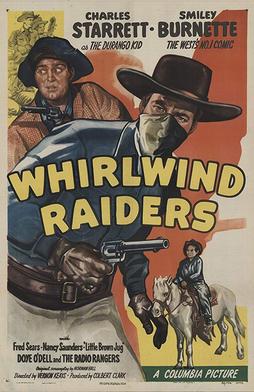
Charles Robert Starrett was an American actor, best known for his starring role in the Durango Kid westerns. Starrett still holds the record for starring in the longest series of theatrical features: 131 westerns, all produced by Columbia Pictures.

Wheeler Oakman was an American film actor.

Wild Bill Elliott was an American film actor. He specialized in playing the rugged heroes of B Westerns, particularly the Red Ryder series of films.

The Durango Kid is a 1940 American Western directed by Lambert Hillyer, starring Charles Starrett, Luana Walters and Kenneth McDonald. This is the first of 65 Durango Kid movies Starrett made at Columbia Pictures.

Cyclone Fury is a 1951 American Western film directed by Ray Nazarro and starring Charles Starrett. This was the fifty-seventh of 65 films in the Durango Kid series.

Prairie Schooners is a 1940 American Western film directed by Sam Nelson, and stars Wild Bill Elliott, Evelyn Young, and Dub Taylor. It is the first in Columbia Pictures' series of 12 "Wild Bill Hickok" films, followed by Beyond the Sacramento.

Thunder Over the Prairie is a 1941 American western film directed by Lambert Hillyer and written by Betty Burbridge. It is based on the 1935 novel The Medico Rides by James L. Rubel. The film stars Charles Starrett, Cliff Edwards, Eileen O'Hearn, Stanley Brown, Danny Mummert and David Sharpe. The film was released on July 30, 1941, by Columbia Pictures. It is a sequel to The Medico of Painted Springs, released a month earlier. The third "Medico" film, Prairie Stranger, debuted in September.

West of Dodge City is a 1947 American Western film directed by Ray Nazarro and written by Bert Horswell. The film stars Charles Starrett, Nancy Saunders, Mustard, Gravy and Smiley Burnette. The film was released on March 27, 1947, by Columbia Pictures. This was the twenty-first of 65 films in the Durango Kid series.

Prairie Roundup is a 1951 American Western film directed by Fred F. Sears and starring Charles Starrett, Mary Castle and Frank Fenton. This was the fifty-second of 65 films in the Durango Kid series.

The Fighting Frontiersman is a 1946 American Western film directed by Derwin Abrahams and written by Ed Earl Repp. The film stars Charles Starrett, Helen Mowery, Hank Newman and Smiley Burnette. The film was released on December 10, 1946, by Columbia Pictures. This was the eighteenth of 65 films in the Durango Kid series.

South of the Chisholm Trail is a 1947 American Western film directed by Derwin Abrahams and written by Michael Simmons. The film stars Charles Starrett, Nancy Saunders, Hank Newman and Smiley Burnette. The film was released on January 30, 1947, by Columbia Pictures. This was the nineteenth of 65 films in the Durango Kid series.

The Lone Star Vigilantes is a 1942 American Western film directed by Wallace Fox and written by Luci Ward. The film stars Wild Bill Elliott, Tex Ritter, Frank Mitchell, Virginia Carpenter, Luana Walters and Budd Buster. The film was released on January 1, 1942, by Columbia Pictures. It is the ninth in Columbia Pictures' series of 12 "Wild Bill Hickok" films, followed by Bullets for Bandits.

Law of the Canyon is a 1947 American Western film directed by Ray Nazarro and written by Eileen Gary. The film stars Charles Starrett, Nancy Saunders, Robert 'Buzz' Henry, Texas Jim Lewis and Smiley Burnette. The film was released on April 24, 1947, by Columbia Pictures. This was the twenty-second of 65 films in the Durango Kid series.

The Return of the Durango Kid is a 1945 American Western film directed by Derwin Abrahams and written by J. Benton Cheney. The film stars Charles Starrett, Tex Harding, Jean Stevens and John Calvert. The film was released on April 19, 1945, by Columbia Pictures. This was the second of 65 films in the Durango Kid series.

Whirlwind Raiders is a 1948 American Western film directed by Vernon Keays and written by Norman S. Hall. The film stars Charles Starrett, Don Reynolds, Nancy Saunders, Fred F. Sears, Doye O'Dell and Smiley Burnette. The film was released on May 13, 1948, by Columbia Pictures. This was the thirty-first of 65 films in the Durango Kid series.

Frontier Gunlaw is a 1946 American Western film directed by Derwin Abrahams and written by Bennett Cohen. The film stars Charles Starrett, Tex Harding, Dub Taylor, Jean Stevens, Weldon Heyburn and Jack Rockwell. The film was released on January 31, 1946, by Columbia Pictures. This was the ninth of 65 films in the Durango Kid series.

Prairie Raiders is a 1947 American Western film directed by Derwin Abrahams and written by Ed Earl Repp. The film stars Charles Starrett, Nancy Saunders, Mark Roberts, Ozie Waters and Smiley Burnette. The film was released on May 29, 1947, by Columbia Pictures. This was the twenty-third of 65 films in the Durango Kid series.

Prairie Stranger is a 1941 American western film directed by Lambert Hillyer and written by Winston Miller. It is based on the 1936 novel The Medico Rides the Trail by James L. Rubel. The film stars Charles Starrett, Cliff Edwards, Patti McCarty, Forbes Murray, Frank LaRue and Archie R. Twitchell. The film was released on September 18, 1941, by Columbia Pictures. The film is the third in the "Medico" series, which includes The Medico of Painted Springs and Thunder Over the Prairie, released earlier that year.

Two-Fisted Stranger is a 1946 American Western film directed by Ray Nazarro and written by Robert Lee Johnson. The film stars Charles Starrett, Doris Houck, Zeke Clements and Smiley Burnette. The film was released on May 30, 1946, by Columbia Pictures. This was the thirteenth of 65 films in the Durango Kid series.

Six-Gun Law is a 1948 American Western film directed by Ray Nazarro and written by Barry Shipman. The film stars Charles Starrett, Nancy Saunders, Paul Campbell, Hugh Prosser, Curly Clements and Smiley Burnette. The film was released on January 9, 1948, by Columbia Pictures. This was the twenty-eighth of 65 films in the Durango Kid series.




















